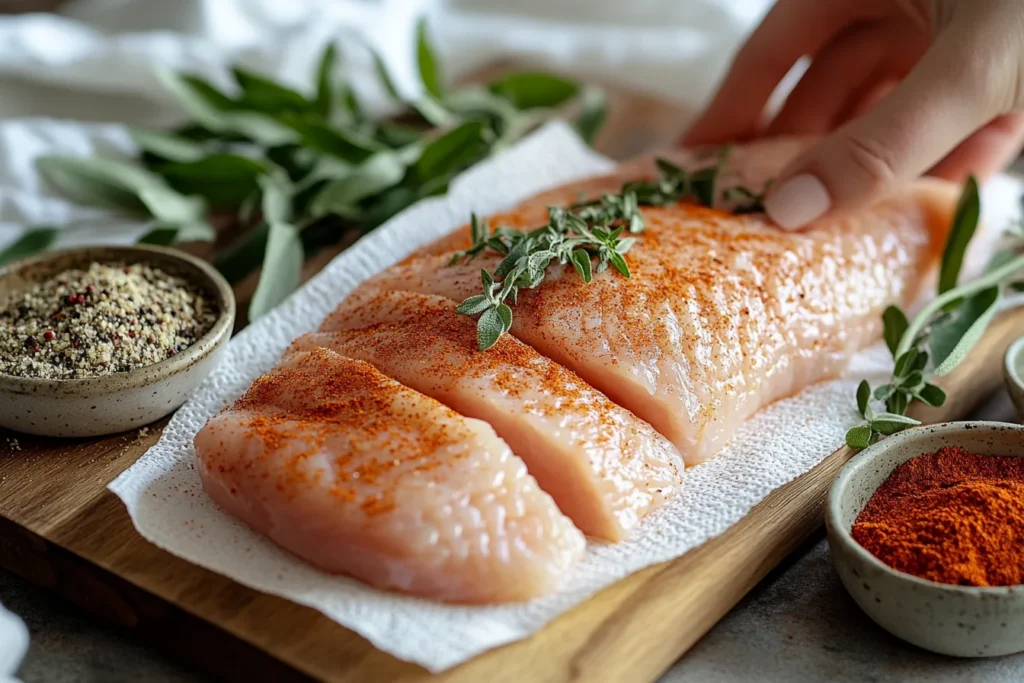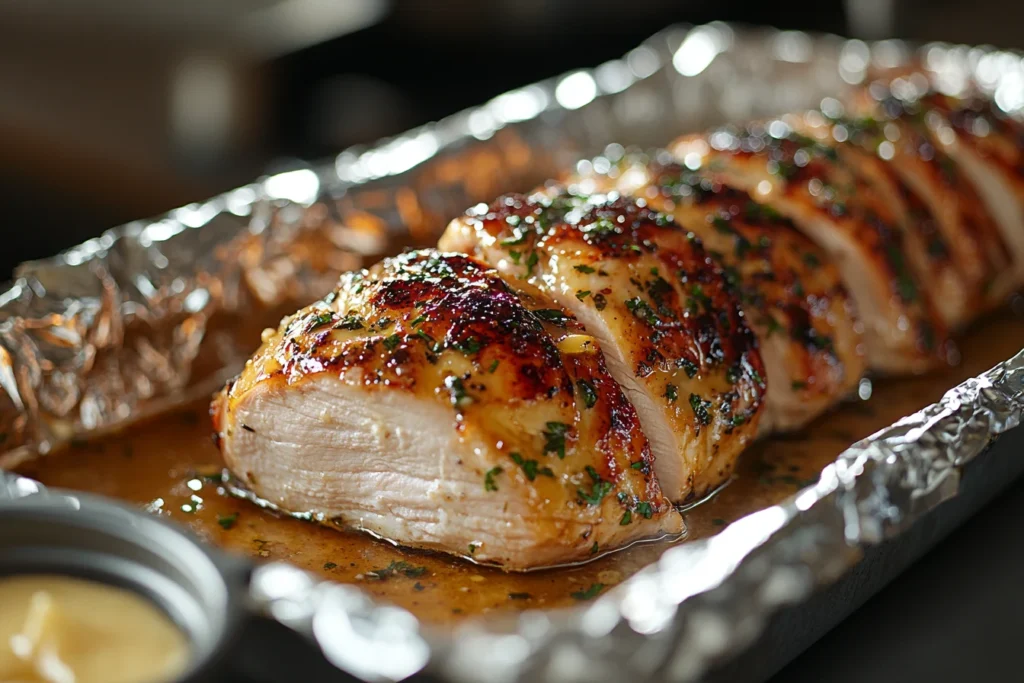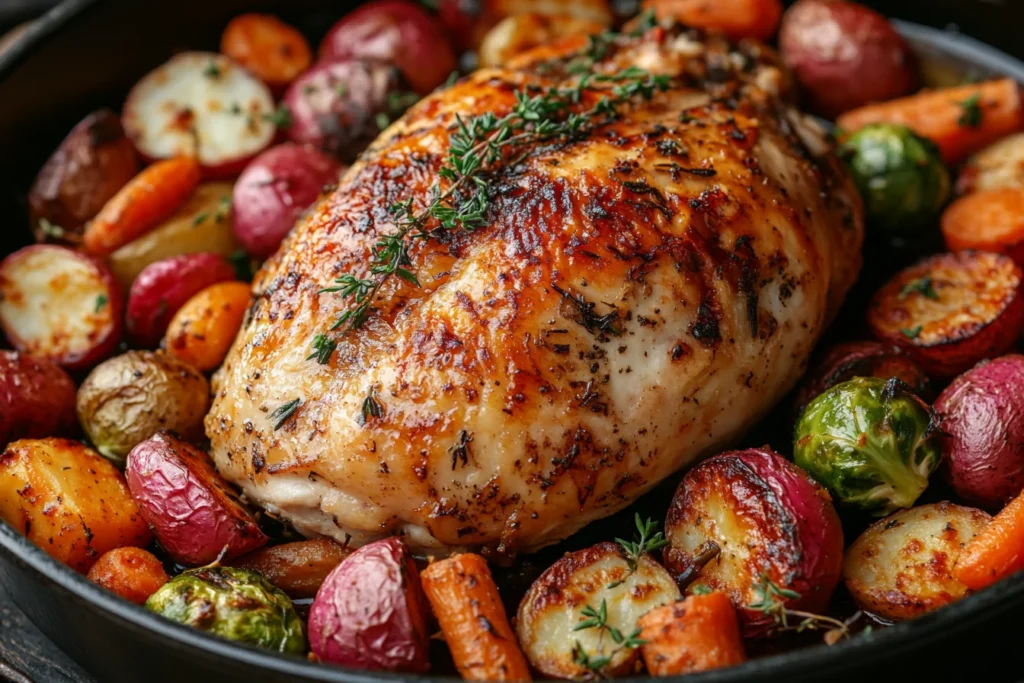Why Covering Turkey Breast Matters
Do You Cover Turkey Breast in the Oven? The answer to this question can greatly effect the final end result of your dish. Covering the turkey breast helps lure moisture, stopping it from drying out all through the cooking technique. Turkey breast, being leaner than dark meat, tends to lose moisture faster. This makes it vital to create a barrier that locks in juices.
When you cover turkey breast, the warmth circulates extra evenly, resulting in a smooth, juicy texture. This method also allows the flavors of any seasonings or marinades to permeate the meat higher. Additionally, masking can defend the surface from browning too fast, ensuring the turkey chefs very well without burning. For extra flavorful cooking thoughts, take a look at out our Creole Butter Turkey Breast Recipe or analyze What Can I Mix With Rice to Make It Taste Better? for a super aspect dish.
Whether you’re cooking for a vacation collecting or a weeknight meal, expertise the function of overlaying in baking turkey breast can make all the distinction. This easy approach helps achieve regular, flavorful results on every occasion.

Table of Contents
Choosing the Right Covering Material
When asking, do you cover turkey breast in the oven?, it’s important to consider the type of covering material you use. The right choice depends on the outcome you’re aiming for and the tools available in your kitchen.
Common Covering Materials:
Aluminum Foil: A versatile option that traps moisture effectively and prevents the turkey from drying out. It also helps maintain even cooking temperatures.
Parchment Paper: A healthier alternative to foil, it keeps the turkey moist while allowing some airflow.
A Roasting Lid: If you’re using a covered roasting pan, this eliminates the need for foil or parchment. The lid retains heat and moisture effectively.
Cheesecloth: For added flavor, you can soak cheesecloth in butter or broth and drape it over the turkey breast.
Each material offers unique benefits, so consider your priorities—whether it’s simplicity, flavor infusion, or eco-friendliness. Covering your turkey breast properly ensures a juicy, well-cooked dish, no matter the method you choose.
Steps to Prepare Turkey Breast for Baking
Before answering do you cover turkey breast in the oven?, it’s essential to prepare the meat correctly. Proper preparation lays the foundation for a perfectly cooked dish.
Preparation Steps:
Thaw Completely: Always ensure the turkey breast is fully thawed if it was frozen. This prevents uneven cooking.
Pat Dry: Use paper towels to remove excess moisture, which helps the seasoning adhere better.
Season Generously: Rub the turkey breast with a mixture of olive oil or butter and your choice of spices. Common seasonings include garlic powder, paprika, thyme, and salt.
Choose a Baking Dish: Place the turkey breast in a roasting pan or baking dish that allows enough space for air circulation.
Add Liquid: Pour a small amount of broth, water, or wine into the pan to create steam during cooking.
Once prepared, you can decide whether to cover the turkey breast in the oven based on your desired result. Covering at the right stage helps maintain moisture and flavor throughout the cooking process.
When to Cover Turkey Breast in the Oven
So, do you cover turkey breast in the oven from start to finish? The answer depends on your cooking method and the texture you’re aiming for.
Covering Guidelines:
Start Covered: Cover the turkey breast with foil or a roasting lid during the first half of cooking. This locks in moisture while the meat cooks evenly.
Finish Uncovered: Remove the covering in the last 15-20 minutes to allow the surface to brown and develop a flavorful crust.
Low and Slow Cooking: If using a lower temperature, you may need to cover the entire time to prevent drying out.
Should You Always Cover Turkey Breast?
The question do you cover turkey breast in the oven? often comes down to personal preference and desired results. Covering turkey breast ensures a moist, tender texture, especially for those concerned about dryness. It’s an excellent option for lean cuts of meat, which tend to lose moisture faster than darker meat.
However, keeping the turkey breast uncovered can allow the surface to brown beautifully, adding a golden, crispy finish. This makes the dish visually appealing and enhances the flavor of the crust. For many cooks, a combination of both methods works best—starting with the turkey covered and uncovering it toward the end of the cooking process.
So, while you don’t always have to cover turkey breast, knowing when and why to do so helps you achieve a juicy, flavorful result tailored to your preferences.
Uncovered vs. Covered Baking
Do you cover turkey breast in the oven, or leave it uncovered? Both approaches have their merits, and the best choice often depends on the outcome you’re aiming for.
Covered Baking
Pros:
Retains moisture, keeping the meat tender.
Protects the turkey from browning too quickly.
Creates a gentle cooking environment, reducing the risk of overcooking.
Cons:
Prevents the skin or surface from crisping.
Uncovered Baking
Pros:
Results in a golden, crispy exterior.
Enhances the flavor of the turkey’s crust.
Cons:
Risk of the turkey drying out if overcooked.
For the best of both worlds, cover the turkey breast during the first part of baking, then uncover it in the final 15-20 minutes for browning.
How to Prevent Turkey Breast from Drying Out
If you’re wondering, do you cover turkey breast in the oven to avoid dryness, the answer is often yes. But there are other techniques to ensure a juicy turkey breast:
Use a Brine: Soaking the turkey in a saltwater solution before cooking locks in moisture.
Butter or Oil Rub: Coat the turkey breast with butter or olive oil to create a barrier that prevents moisture loss.
Add Liquid to the Pan: Pour a small amount of broth or water into the baking dish to create steam.
Cover Strategically: Use foil or a lid to trap moisture during the initial cooking phase.
Monitor Cooking Time: Avoid overcooking by checking the turkey’s internal temperature regularly.
Combining these strategies with covering ensures your turkey breast remains juicy and flavorful.

Using a Meat Thermometer
Do you cover turkey breast in the oven to ensure it’s cooked through? While covering helps retain moisture, a meat thermometer is your best tool for achieving perfect results.
Benefits of Using a Meat Thermometer:
Accuracy: Ensures the turkey is cooked to the recommended internal temperature of 165°F.
Prevents Overcooking: Helps avoid drying out the meat by monitoring it closely.
Safety: Confirms the turkey is fully cooked and safe to eat.
Insert the thermometer into the thickest part of the breast, making sure it doesn’t touch bone. If the turkey hasn’t reached 165°F, return it to the oven, covered if needed, to prevent further moisture loss.
Baking Turkey Breast with Vegetables
Adding vegetables to your dish can enhance both flavor and presentation. But do you cover turkey breast in the oven when baking with vegetables?
The answer often depends on the type of vegetables and the desired texture. Covering the turkey traps steam, which helps the vegetables cook evenly and retain moisture. However, uncovering during the last part of baking allows them to caramelize, intensifying their flavor.
Popular Vegetables to Include:
Carrots and Potatoes: Classic choices that roast beautifully alongside turkey.
Brussels Sprouts: Pair well with the savory flavors of turkey.
Onions and Garlic: Add aromatic depth to the dish.
Resting the Turkey Breast After Baking
When answering do you cover turkey breast in the oven, it’s just as important to address what happens after baking. Resting the turkey breast is a crucial step to ensure it stays juicy and flavorful.
Once the turkey breast reaches an internal temperature of 165°F, remove it from the oven and let it rest for 10-15 minutes before slicing. Resting allows the juices to redistribute throughout the meat, preventing them from spilling out when the turkey is cut.
Tips for Resting:
Cover Loosely with Foil: Tent the turkey breast with aluminum foil to keep it warm without trapping too much steam.
Avoid Skipping This Step: Cutting too early can result in dry meat, even if it was perfectly cooked.
Resting may seem like a small detail, but it’s essential for achieving tender, moist turkey breast every time.
Common Mistakes to Avoid
If you’ve ever asked, do you cover turkey breast in the oven, you’re likely aiming for a successful dish. Avoiding common mistakes can help you get the best results:
Skipping the Covering: Not covering the turkey at all can lead to dryness, especially for lean cuts like the breast.
Overcooking: Baking beyond 165°F will dry out the turkey. Use a meat thermometer for accuracy.
Not Adding Liquid: Forgetting to add broth or water to the pan can prevent steam from forming, making the meat less tender.
Skipping the Rest Period: Cutting the turkey immediately after baking causes the juices to escape, leaving the meat dry.
By avoiding these pitfalls, you’ll ensure your turkey breast turns out juicy, tender, and full of flavor.

Health Benefits of Turkey Breast
In addition to asking, do you cover turkey breast in the oven, it’s worth considering the health benefits of this lean protein. Turkey breast is a nutritious choice for any meal, offering a variety of benefits:
High in Protein: Turkey breast provides a generous amount of protein, which supports muscle growth and repair.
Low in Fat: With minimal fat content, it’s an excellent option for those watching their calorie intake.
Rich in Nutrients: Turkey breast contains essential vitamins and minerals like B6, niacin, and selenium, which promote overall health.
Heart-Healthy: Its low saturated fat content makes it a heart-friendly protein choice.
FAQs About Covering Turkey Breast
Do you always need to cover turkey breast in the oven?
Not always. Covering helps retain moisture and prevents dryness, but uncovering at the end of cooking allows the surface to brown and crisp.
What should I use to cover turkey breast?
Aluminum foil is the most common choice, but parchment paper, a roasting pan lid, or cheesecloth soaked in butter also work well.
Can I cook turkey breast uncovered the whole time?
Yes, but it’s not recommended for lean cuts like turkey breast, as it increases the risk of drying out. Adding liquid to the pan can help compensate.
When should I uncover turkey breast while baking?
Uncover the turkey breast in the last 15-20 minutes of cooking to allow the surface to brown and develop a flavorful crust.
Conclusion
Do you cover turkey breast inside the oven? The solution relies upon for your cooking goals, but knowledge whilst and how to use this method ensures a gentle, flavorful dish every time. Covering the turkey breast all through baking locks in moisture, at the same time as uncovering it towards the cease creates a golden, crispy outdoors.
By pairing this approach with right instruction, the proper gear, and careful monitoring of cooking time, you could acquire consistently scrumptious outcomes. Whether you’re preparing turkey breast for a weeknight dinner or a special occasion, these suggestions help you avoid common errors and create a meal everyone will experience.
Remember, resting the turkey after baking is simply as vital as covering it throughout cooking. This final step ensures a juicy and enjoyable turkey breast. Use these insights to with a bit of luck put together a wonderfully cooked turkey breast every time!

